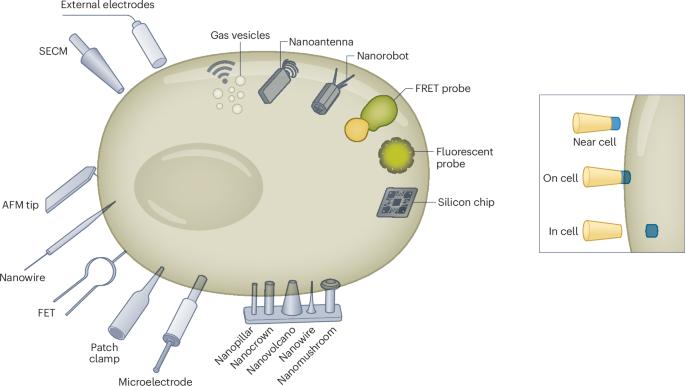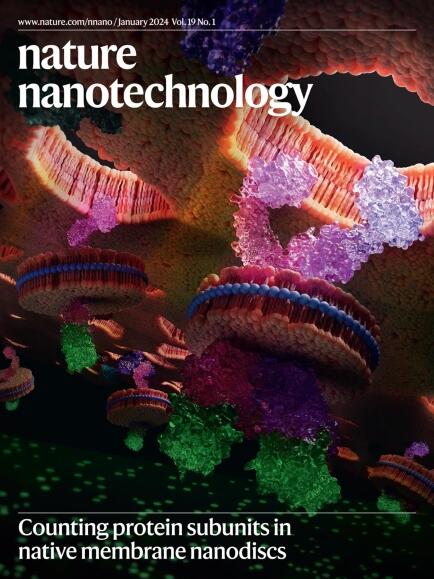Nanosensors for real-time intracellular analytics
IF 34.9
1区 材料科学
Q1 MATERIALS SCIENCE, MULTIDISCIPLINARY
引用次数: 0
Abstract
A fundamental goal in modern biology and precision medicine is to acquire rich, multi-omics-style information from cells, including transcriptomic, proteomic, metabolic and electrophysiological data, in real time and at single-cell resolution. However, current techniques often rely on destructive endpoint assays that require cell lysis, losing spatial, temporal and dynamic context. Nanoscale sensors offer a transformative solution by enabling minimally invasive, continuous monitoring of intracellular activities. Here we propose a spatial classification of intracellular sensing technologies—near cell, on cell and in cell—and use this framework to evaluate the sensing modalities on the basis of their invasiveness, signal fidelity and resolution. We highlight emerging sensor platforms that are capable of detecting ions, metabolites, electrical signals and mechanical changes, as well as artificial intelligence-driven strategies for decoding complex cellular data streams. We further consider the integration of these nanosensors into three-dimensional, physiologically relevant models such as organoids to create ‘smart organoids’ that report on their internal state autonomously and in real time. Finally, we discuss the major challenges in achieving intelligent intracellular sensing, including issues of sensor miniaturization, biocompatibility, multiplexing and three-dimensional integration. Together, these advances set the stage for a new era of dynamic, high-resolution cell profiling that can accelerate drug discovery, disease modelling and personalized medicine. This Review provides insights into nanosensor technologies for monitoring cellular biomarkers, proposing a spatial framework to clarify their distinct advantages, challenges and performance for high-resolution, dynamic profiling of cellular analytes.

用于实时胞内分析的纳米传感器。
现代生物学和精准医学的一个基本目标是从细胞中获取丰富的、多组学类型的信息,包括转录组学、蛋白质组学、代谢和电生理数据,实时和单细胞分辨率。然而,目前的技术通常依赖于需要细胞裂解的破坏性终点分析,失去了空间、时间和动态背景。纳米级传感器提供了一种变革性的解决方案,使微创、连续监测细胞内活动成为可能。在这里,我们提出了细胞内传感技术的空间分类-细胞附近,细胞上和细胞内-并使用该框架来评估基于其侵入性,信号保真度和分辨率的传感模式。我们重点介绍了能够检测离子、代谢物、电信号和机械变化的新兴传感器平台,以及用于解码复杂细胞数据流的人工智能驱动策略。我们进一步考虑将这些纳米传感器集成到三维生理相关模型中,如类器官,以创建“智能类器官”,自动实时报告其内部状态。最后,我们讨论了实现智能细胞内传感的主要挑战,包括传感器小型化、生物相容性、多路复用和三维集成等问题。总之,这些进步为动态、高分辨率细胞分析的新时代奠定了基础,可以加速药物发现、疾病建模和个性化医疗。
本文章由计算机程序翻译,如有差异,请以英文原文为准。
求助全文
约1分钟内获得全文
求助全文
来源期刊

Nature nanotechnology
工程技术-材料科学:综合
CiteScore
59.70
自引率
0.80%
发文量
196
审稿时长
4-8 weeks
期刊介绍:
Nature Nanotechnology is a prestigious journal that publishes high-quality papers in various areas of nanoscience and nanotechnology. The journal focuses on the design, characterization, and production of structures, devices, and systems that manipulate and control materials at atomic, molecular, and macromolecular scales. It encompasses both bottom-up and top-down approaches, as well as their combinations.
Furthermore, Nature Nanotechnology fosters the exchange of ideas among researchers from diverse disciplines such as chemistry, physics, material science, biomedical research, engineering, and more. It promotes collaboration at the forefront of this multidisciplinary field. The journal covers a wide range of topics, from fundamental research in physics, chemistry, and biology, including computational work and simulations, to the development of innovative devices and technologies for various industrial sectors such as information technology, medicine, manufacturing, high-performance materials, energy, and environmental technologies. It includes coverage of organic, inorganic, and hybrid materials.
 求助内容:
求助内容: 应助结果提醒方式:
应助结果提醒方式:


